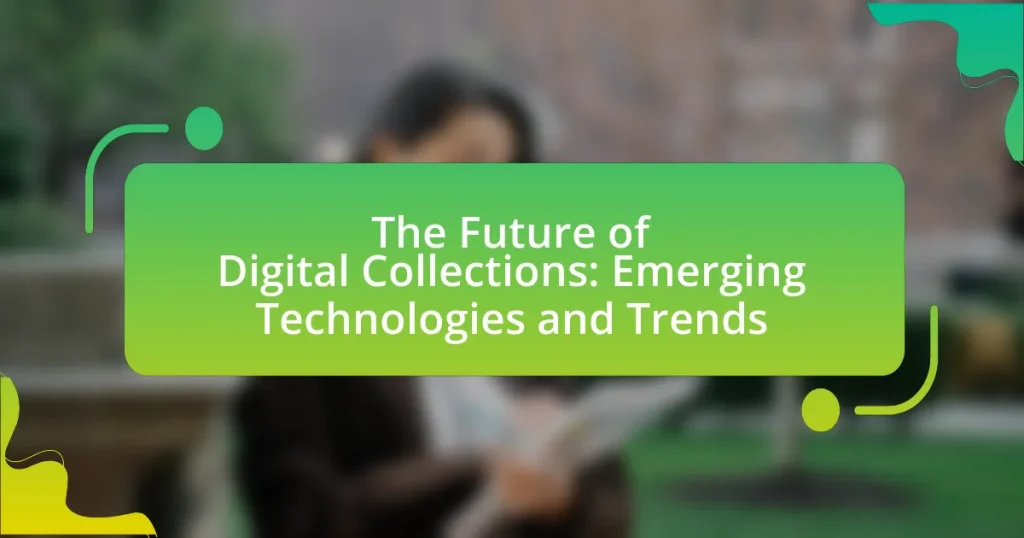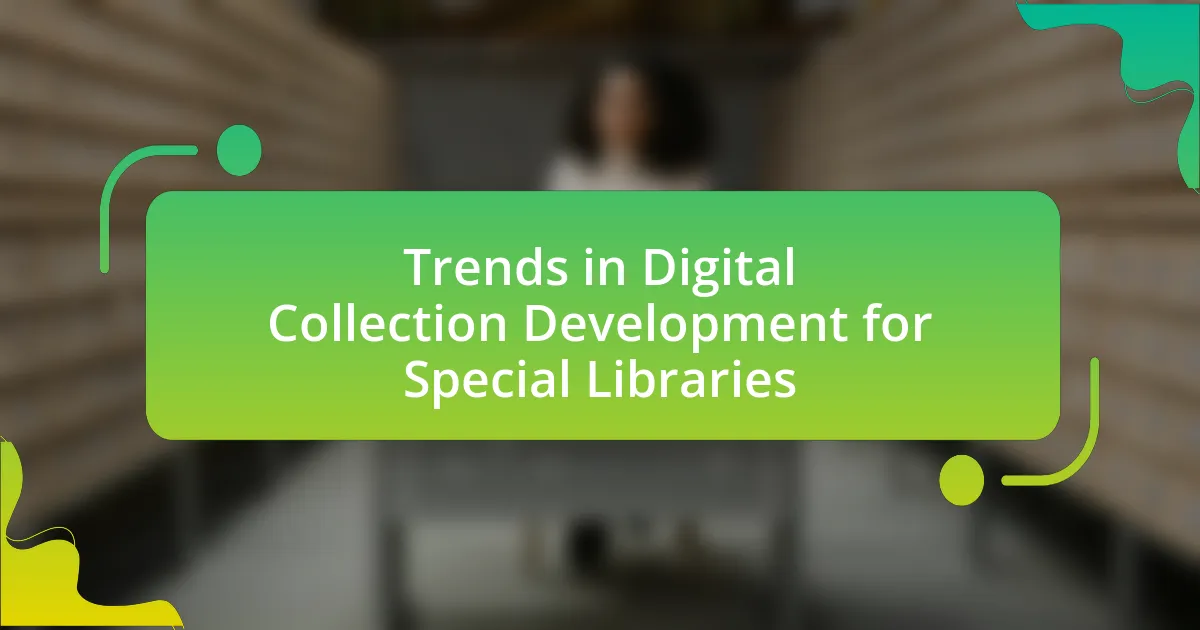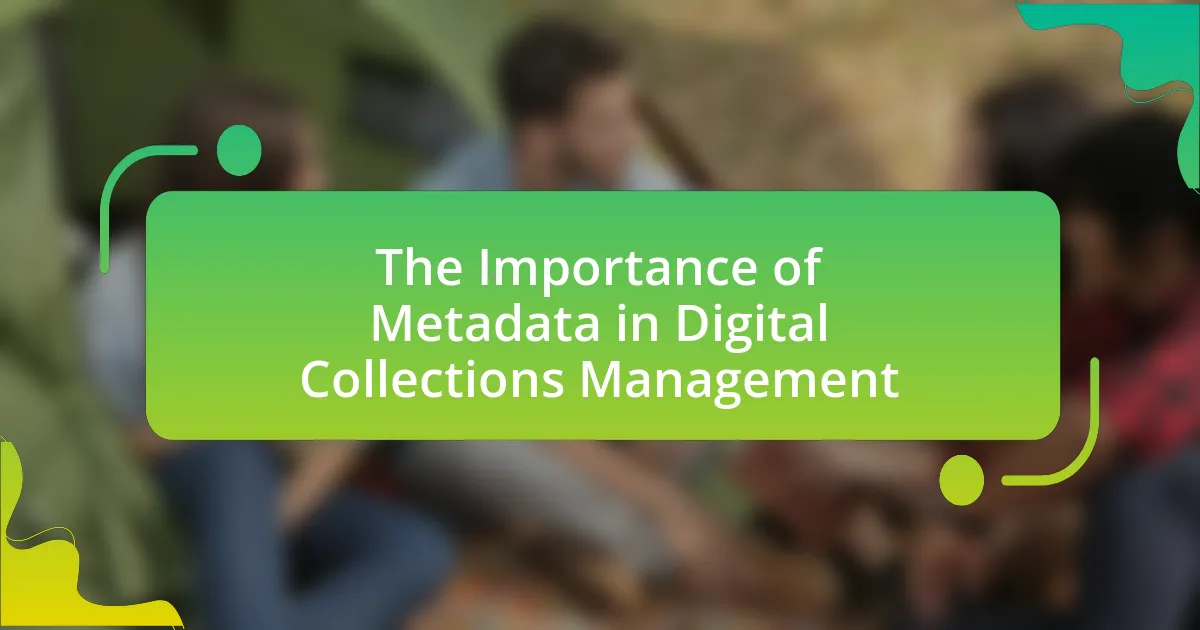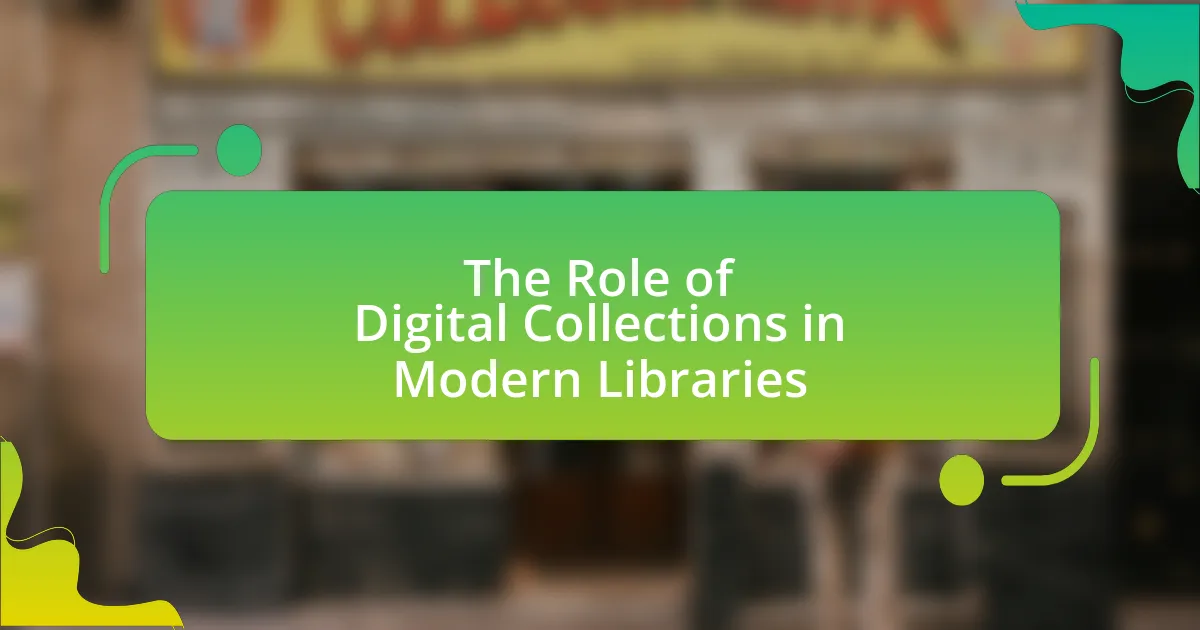Digital collections are curated groups of digital objects, including documents, images, audio, and video, that enhance accessibility, preserve cultural heritage, and facilitate research and education. This article explores the significance of digital collections, their differences from traditional collections, and key characteristics such as organization and preservation. It examines the role of emerging technologies like artificial intelligence and blockchain in transforming digital collections, improving user engagement, and ensuring authenticity. Additionally, the article discusses trends shaping the future of digital collections, challenges organizations face in implementing these technologies, and best practices for effective management and preservation.
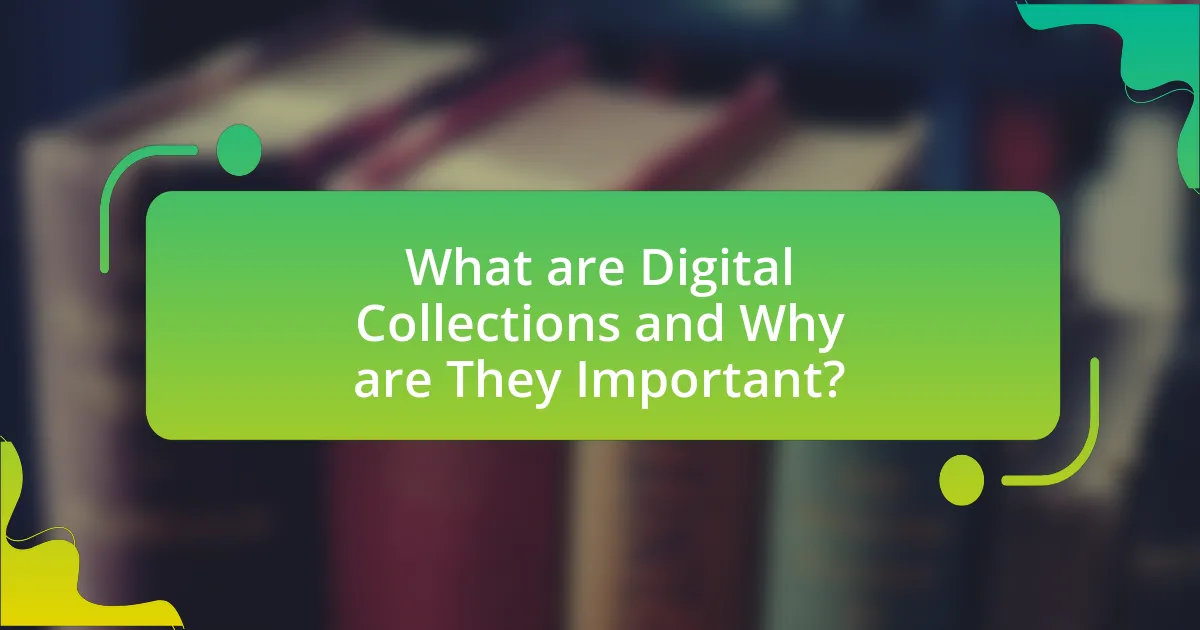
What are Digital Collections and Why are They Important?
Digital collections are curated groups of digital objects, such as documents, images, audio, and video, that are stored and accessed electronically. They are important because they enhance accessibility to information, preserve cultural heritage, and facilitate research and education. For instance, the Digital Public Library of America provides access to millions of photographs, manuscripts, and other artifacts, making historical resources available to a global audience. This democratization of information supports knowledge sharing and fosters innovation across various fields.
How do Digital Collections differ from Traditional Collections?
Digital collections differ from traditional collections primarily in their format and accessibility. Digital collections are stored electronically, allowing for easy access and sharing over the internet, while traditional collections consist of physical items that require in-person access. For instance, digital collections can include a vast array of multimedia formats such as images, videos, and interactive content, which are not possible in traditional collections. Additionally, digital collections can be updated and expanded rapidly, whereas traditional collections often involve time-consuming processes for acquisition and cataloging. This difference in format and accessibility highlights the transformative impact of technology on how collections are created, managed, and utilized in contemporary settings.
What are the key characteristics of Digital Collections?
Digital collections are characterized by their accessibility, organization, and preservation of digital assets. They provide users with easy access to a wide range of digital materials, such as texts, images, and multimedia, often through online platforms. The organization of these collections typically involves metadata standards that enhance searchability and retrieval, ensuring that users can efficiently locate specific items. Additionally, digital collections prioritize the long-term preservation of digital content, employing strategies like regular backups and format migrations to combat obsolescence. These characteristics are essential for facilitating research, education, and cultural heritage preservation in the digital age.
Why is the transition to Digital Collections significant?
The transition to Digital Collections is significant because it enhances accessibility and preservation of information. Digital Collections allow users to access vast amounts of data from anywhere, breaking geographical barriers and enabling broader participation in research and education. For instance, the Digital Public Library of America provides access to millions of photographs, manuscripts, and other resources, demonstrating how digital formats can democratize knowledge. Additionally, digital formats ensure that materials are preserved against physical degradation, as seen in initiatives like the Internet Archive, which aims to preserve web pages and digital content for future generations.
What role do Emerging Technologies play in Digital Collections?
Emerging technologies play a crucial role in enhancing digital collections by improving accessibility, preservation, and user engagement. These technologies, such as artificial intelligence, machine learning, and blockchain, facilitate the organization and retrieval of vast amounts of data, making it easier for users to find and interact with digital assets. For instance, AI-driven algorithms can analyze user behavior to personalize content recommendations, while blockchain ensures the authenticity and provenance of digital items. The integration of these technologies not only streamlines the management of digital collections but also enriches the user experience, as evidenced by the increasing adoption of AI in libraries and museums to curate and present collections more effectively.
How is Artificial Intelligence transforming Digital Collections?
Artificial Intelligence is transforming digital collections by enhancing data organization, improving accessibility, and enabling advanced analytics. AI algorithms can automatically categorize and tag vast amounts of digital content, making it easier for users to search and retrieve relevant information. For instance, machine learning techniques can analyze user behavior and preferences, allowing for personalized recommendations and improved user experiences. Additionally, AI-powered tools can extract metadata from unstructured data, facilitating better management of digital assets. According to a report by the International Federation of Library Associations and Institutions, AI applications in libraries and archives have increased efficiency in managing collections by up to 30%.
What impact does Blockchain have on the authenticity of Digital Collections?
Blockchain significantly enhances the authenticity of digital collections by providing a decentralized and immutable ledger for recording ownership and provenance. This technology ensures that each digital asset is uniquely identifiable and verifiable, reducing the risk of forgery and unauthorized alterations. For instance, when a digital artwork is registered on a blockchain, its ownership history is permanently recorded, allowing buyers and collectors to trace its provenance back to the original creator. This traceability is crucial in the art market, where authenticity is paramount, as evidenced by the increasing adoption of blockchain by platforms like Artory and Verisart, which specialize in verifying art provenance. Thus, blockchain not only secures the authenticity of digital collections but also fosters trust among creators and consumers in the digital marketplace.
What trends are shaping the future of Digital Collections?
The future of Digital Collections is being shaped by trends such as increased use of artificial intelligence, enhanced user engagement through interactive interfaces, and the integration of blockchain technology for provenance tracking. Artificial intelligence is streamlining the organization and retrieval of digital assets, allowing for more efficient curation and personalized user experiences. Interactive interfaces are fostering deeper engagement by enabling users to explore collections in immersive ways, such as through virtual reality. Additionally, blockchain technology is providing secure and transparent methods for tracking the ownership and history of digital items, which is crucial for maintaining trust in digital collections. These trends are supported by industry reports indicating that organizations adopting these technologies see improved user satisfaction and operational efficiency.
How is user engagement evolving in Digital Collections?
User engagement in Digital Collections is evolving through increased interactivity and personalization. Recent trends indicate that users are seeking more immersive experiences, such as virtual reality and augmented reality applications, which enhance their interaction with digital content. For instance, a study by the Pew Research Center found that 72% of users prefer platforms that offer personalized recommendations based on their previous interactions, demonstrating a shift towards tailored user experiences. Additionally, the integration of social media features allows users to share and discuss content, further increasing engagement levels. These developments highlight a clear trajectory towards more dynamic and user-centered digital environments.
What are the implications of Virtual and Augmented Reality for Digital Collections?
Virtual and Augmented Reality (VR and AR) significantly enhance digital collections by providing immersive experiences that engage users more deeply. These technologies allow users to interact with digital artifacts in a three-dimensional space, facilitating a better understanding of context and detail. For instance, museums employing VR can recreate historical environments, enabling visitors to experience artifacts in their original settings, which has been shown to increase retention of information by up to 70%. Additionally, AR can overlay digital information onto physical objects, enriching the user’s experience with interactive content that can be accessed through mobile devices. This integration of VR and AR not only broadens accessibility to digital collections but also fosters innovative educational opportunities, making learning more engaging and effective.
How can organizations adapt to these changes in Digital Collections?
Organizations can adapt to changes in digital collections by implementing advanced technologies such as artificial intelligence and machine learning for better data management and user experience. These technologies enable organizations to automate cataloging processes, enhance search functionalities, and personalize user interactions, thereby improving accessibility and engagement with digital collections. For instance, a study by the Pew Research Center indicates that 73% of libraries are using technology to enhance user experience, demonstrating a trend towards digital transformation in information management.
What challenges do organizations face in implementing Emerging Technologies?
Organizations face several challenges in implementing emerging technologies, including high costs, lack of skilled personnel, and resistance to change. High costs can deter organizations from adopting new technologies, as initial investments in infrastructure and training can be substantial. Additionally, a shortage of skilled personnel limits the ability to effectively integrate and utilize these technologies, as many organizations struggle to find employees with the necessary expertise. Resistance to change often arises from employees who are accustomed to existing processes and may be hesitant to adopt new systems, leading to potential disruptions in workflow. According to a report by McKinsey & Company, 70% of digital transformation initiatives fail due to these types of challenges, highlighting the significant barriers organizations must overcome to successfully implement emerging technologies.
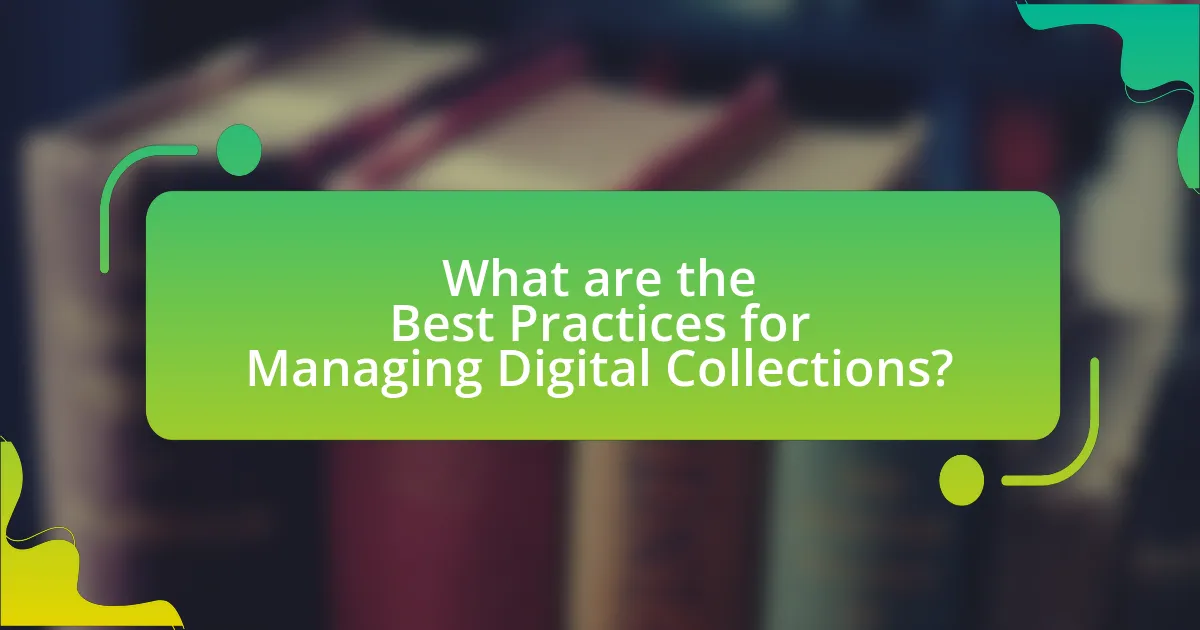
What are the Best Practices for Managing Digital Collections?
The best practices for managing digital collections include establishing clear metadata standards, ensuring regular backups, implementing robust access controls, and providing user training. Clear metadata standards enhance discoverability and interoperability, as evidenced by the Dublin Core Metadata Initiative, which provides guidelines widely adopted in digital libraries. Regular backups protect against data loss, with the National Digital Stewardship Alliance recommending a 3-2-1 backup strategy (three copies of data, two different media, one off-site). Robust access controls safeguard sensitive information and comply with privacy regulations, such as GDPR. User training fosters effective utilization of digital collections, as demonstrated by studies showing that trained users are more likely to engage with and benefit from digital resources.
How can organizations ensure the preservation of Digital Collections?
Organizations can ensure the preservation of digital collections by implementing robust digital preservation strategies that include regular backups, metadata management, and format migration. Regular backups protect against data loss, while effective metadata management ensures that digital assets are easily discoverable and usable over time. Format migration is essential as technology evolves, allowing organizations to transfer digital content to current formats to prevent obsolescence. According to the Digital Preservation Coalition, 70% of digital content is at risk of being lost due to format obsolescence, highlighting the necessity of these strategies for long-term preservation.
What strategies are effective for digital preservation?
Effective strategies for digital preservation include regular data backups, the use of standardized file formats, and implementing metadata standards. Regular data backups ensure that digital assets are not lost due to hardware failures or accidental deletions, with best practices recommending backups at least once a week. Utilizing standardized file formats, such as PDF/A for documents and TIFF for images, enhances the longevity and accessibility of digital files, as these formats are widely supported and less likely to become obsolete. Implementing metadata standards, like Dublin Core or PREMIS, facilitates better organization and retrieval of digital collections, ensuring that essential information about the files is preserved alongside the content. These strategies are supported by research from the Digital Preservation Coalition, which emphasizes the importance of these practices in maintaining the integrity and accessibility of digital collections over time.
How can metadata enhance the usability of Digital Collections?
Metadata enhances the usability of digital collections by providing structured information that facilitates efficient search, retrieval, and organization of digital assets. By employing standardized metadata schemas, users can easily locate relevant materials through improved indexing and categorization. For instance, the Dublin Core metadata standard allows for consistent description of resources, which aids in interoperability across different systems. Furthermore, metadata enriches user experience by offering context, such as creator information, date of creation, and subject matter, enabling users to understand the significance and relevance of the digital items. Studies have shown that well-implemented metadata can increase user engagement and satisfaction, as it allows for more intuitive navigation and discovery within digital collections.
What are the ethical considerations in Digital Collections?
Ethical considerations in digital collections include issues of copyright, privacy, accessibility, and cultural sensitivity. Copyright laws dictate how digital materials can be used and shared, requiring institutions to navigate licensing agreements carefully to avoid infringement. Privacy concerns arise when personal data is collected or when sensitive information is included in collections, necessitating adherence to data protection regulations. Accessibility is crucial to ensure that digital collections are usable by individuals with disabilities, aligning with standards such as the Web Content Accessibility Guidelines (WCAG). Cultural sensitivity involves respecting the origins and contexts of materials, particularly when dealing with indigenous or marginalized communities, ensuring that their rights and narratives are honored. These considerations are essential for maintaining ethical integrity in the management and dissemination of digital collections.
How can organizations address issues of copyright and ownership?
Organizations can address issues of copyright and ownership by implementing clear policies that define the ownership of digital content and ensuring compliance with copyright laws. Establishing a framework for licensing agreements and using Creative Commons licenses can facilitate the sharing of digital collections while protecting intellectual property rights. Additionally, organizations should conduct regular audits of their digital assets to identify potential copyright infringements and provide training for staff on copyright issues. This approach is supported by the fact that organizations that actively manage their copyright policies reduce the risk of legal disputes and enhance their ability to share resources responsibly.
What measures can be taken to ensure equitable access to Digital Collections?
To ensure equitable access to Digital Collections, institutions should implement strategies such as providing open access policies, enhancing digital literacy programs, and ensuring compatibility with assistive technologies. Open access policies allow users from diverse backgrounds to freely access digital resources, which is supported by the fact that institutions like the Public Library of Science have demonstrated increased engagement when resources are made available without paywalls. Enhancing digital literacy programs equips users with the necessary skills to navigate and utilize digital collections effectively, as evidenced by studies showing that targeted training increases user engagement and satisfaction. Additionally, ensuring compatibility with assistive technologies, such as screen readers, is crucial for inclusivity, as approximately 15% of the global population experiences some form of disability, highlighting the need for accessible digital environments.

What is the Future Outlook for Digital Collections?
The future outlook for digital collections is highly promising, driven by advancements in technology and increasing demand for accessible information. Emerging technologies such as artificial intelligence, machine learning, and blockchain are enhancing the organization, preservation, and accessibility of digital collections. For instance, AI algorithms can automate metadata generation, improving searchability and user experience. Additionally, the global digital content market is projected to grow significantly, with estimates suggesting it will reach over $400 billion by 2025, indicating a robust demand for digital collections. This growth is further supported by the increasing digitization efforts by libraries, museums, and archives, which aim to preserve cultural heritage and make it widely available.
How will user expectations influence the development of Digital Collections?
User expectations will significantly influence the development of Digital Collections by driving the demand for enhanced accessibility, personalization, and interactivity. As users increasingly seek seamless experiences, digital collections must adapt to provide intuitive interfaces, tailored content, and engaging features. For instance, a study by the Pew Research Center indicates that 73% of users prefer personalized content, highlighting the necessity for digital collections to incorporate user data for customization. This shift towards user-centric design will shape the future of digital collections, ensuring they meet evolving expectations and remain relevant in a competitive digital landscape.
What emerging user trends should organizations be aware of?
Organizations should be aware of the trend towards personalized user experiences driven by artificial intelligence and machine learning. This trend is evidenced by a 2022 McKinsey report indicating that 71% of consumers expect companies to deliver personalized interactions. Additionally, the rise of mobile-first design reflects user preferences for accessing digital collections via smartphones, with Statista reporting that mobile devices accounted for over 54% of global website traffic in 2023. Furthermore, the increasing demand for sustainability in digital services is shaping user expectations, as a 2021 Deloitte survey found that 62% of consumers prefer brands that demonstrate environmental responsibility. These trends highlight the necessity for organizations to adapt their strategies to meet evolving user needs effectively.
How can organizations leverage data analytics to improve Digital Collections?
Organizations can leverage data analytics to improve digital collections by analyzing user engagement metrics to tailor content and enhance user experience. By utilizing tools such as Google Analytics, organizations can track how users interact with digital collections, identifying popular items and user demographics. This data allows for informed decisions on content curation, ensuring that collections reflect user interests and needs. Furthermore, predictive analytics can forecast trends in user behavior, enabling organizations to proactively update and expand their collections. For instance, a study by the Pew Research Center found that data-driven decision-making significantly enhances user satisfaction and engagement in digital platforms.
What practical steps can organizations take to stay ahead in Digital Collections?
Organizations can stay ahead in Digital Collections by implementing advanced data management systems, leveraging artificial intelligence for content curation, and enhancing user experience through intuitive interfaces. Advanced data management systems enable efficient organization and retrieval of digital assets, ensuring that collections remain accessible and relevant. Utilizing artificial intelligence allows organizations to automate the curation process, analyze user behavior, and personalize content recommendations, which can significantly improve engagement. Additionally, enhancing user experience through intuitive interfaces ensures that users can easily navigate and interact with digital collections, leading to increased usage and satisfaction. These steps are supported by industry trends indicating that organizations adopting these technologies see improved operational efficiency and user engagement metrics.
